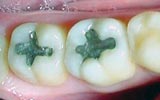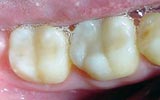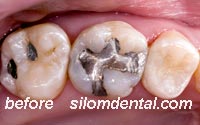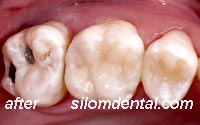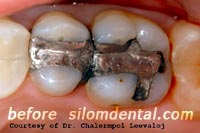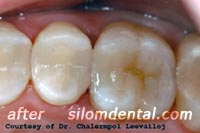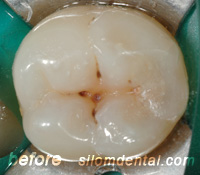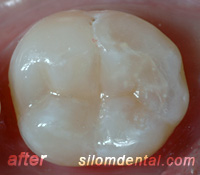 |
|
| www.silomdental.com |
Composite Filling, Composite Resin (Plastic)
Bangkok, Thailand
Bangkok, Thailand
Composite fillings are the newest type of filling in common usage. They are commonly known as white fillings. They are a porcelain/plastic hybrid that is bonded directly to the cavity preparation. Composite fillings were created as an alternative to traditional metal dental fillings. They are colored to look like natural teeth and are more esthetically pleasing than amalgam or gold fillings. They are also strong, durable, and make for a very natural looking smile. From a cost standpoint, this tooth colored restoration is closest to silver amalgam, but composite resin restorations must be places nearly perfectly to provide adequate service. They can compete with silver amalgam in small to moderate size tooth defects. Many new materials now make these restorations much better than in the past. These are the most common restorations for front teeth. Your dentist will give you a local anesthetic to numb the area before preparing an access to the decayed area of the tooth and removing the decayed portions. Traditional drills, micro air abrasion or even with a dental laser can be used to accomplish this. A special dental material is then used to open up the pores of your tooth's dentin and roughens up the surface of the exposed enamel. This creates a stronger bond between the tooth and the filling. The bond resin is applied to stick the composite to your tooth. This material is made of the same dental resin as the composite however it is much more fluid. With a composite filling, your dentist will be able to preserve more of the natural tooth as the composite resin can be bonded to the tooth in thin layers and slowly built up to form a complete filling. A bright dental light will harden each layer before the next is applied. If the decayed area of your tooth is close to a nerve, a special liner can be used to protect the nerve. A special dental material is then used to open up the pores of your tooth's dentin and roughens up the surface of the exposed enamel. This creates a stronger bond between the tooth and the filling. The bond resin is applied to stick the composite to your tooth. This material is made of the same dental resin as the composite however it is much more fluid. This layer is then hardened by the bright light in the same way as the composite layers. Once your filling is completed, your dentist will use a special articulating paper, to adjust the height of your dental filling and to ensure that your bite remains correct. Your tooth is then polished. If such a filling is not going to be enough to protect your damaged tooth, or if your tooth enamel is thin and will easily fracture, or if your tooth has had a root canal that weakened your tooth condition, your tooth may require additional protection such as a crown. It is important to discuss this procedure with our dentist as there are several personal and medical factors to take into consideration. You may also have the option of dental bridges or dental implants.
ADVANTAGES & DISADVANTAGE OF COMPOSITE FILLING
RISK A small percentage of teeth into which this material has been placed is sensitive to temperature or pressure after the placement. This sensitivity usually goes away, but a few teeth require endodontic (root canal) therapy because of continued sensitivity. Composite resin wears faster than metals; this characteristic can cause the need for replacement sooner than metals. ALTERNATIVES Where appearance is not a factor, silver amalgam is the most used alternative, but gold inlays and onlays, tooth-colored inlays and onlays, and crowns (caps) may also be considered. Composite filling can be used for cosmetic improvement on front teeth such as composite facing or diastema closure. COST These restorations may cost up to two or three times more than the cost of silver amalgam restorations in back teeth. The higher cost is related to the extra skill required to place these restorations. RESULT OF NONTREATMENT Untreated decay will eventually destroy much of the tooth, kill the dental pulp (nerve), and may require significant expensive therapy to overcome the problem. BEFORE & AFTER OF COMPOSITE FILLING
|
Composite material 3M Kerr |
HOME
l SERVICE
l DENTISTS
l TECHNOLOGY
l FACILITIES
l ABOUT US
l SITE MAP
PROMOTION
l PRICE&DURATION
l CONSULTATION
l FAQ
l LINKS
l MAP
l TESTIMONIALS
l OUR LAB
l RESOURCES
DENTAL BRACES
l TEETH WHITENING
l IMPLANT DENTISTRY
l ENDODONTICS
l OPERATIVE DENTISTRY
l SEDATION DENTISTRY
COSMETIC DENTISTRY
l PROSTHODONTICS
l PERIODONTICS
l ORAL SURGERY
l PAEDODONTICS
l GP & ORAL EXAM
l OCCLUSION
AIR-FLOW
l DENTAL LASER SYSTEM
l ENDODONTIC EQUIPMENT
l DENTAL UNITS
l OPERATING LAMP
l WHITENING SYSTEM
CT SCAN
l DENTAL MICROSCOPES
l NOBEL GUIDE
l STERILIZATION ROOM
l X-RAY
l ELECTROSURGICAL SYSTEM
l MINIPIEZON
DENTAL OFFICE
l DENTAL CLINIC
l COSMETIC DENTISTRY
l COSMETIC DENTIST
l TEETH BLEACHING
l TOOTH WHITENING
DENTAL CROWNS
l DENTAL IMPLANTS
l DENTAL TREATMENT
l DENTAL IMPLANT
............................................................................................................................. Copyright© 2004 SILOM DENTAL BUILDING. All Rights Reserved.
Local Call : 0 2636 9092-5, International Call : (+) 66 2636 9091, (+) 66 2636 9097
e-mail :silomdental@silomdental.com
Operative Dentistry, Restorations, Amalgum Filling, Gold Filling, Composite Filling, Operative Dentistry Dental Clinic Bangkok Thailand
